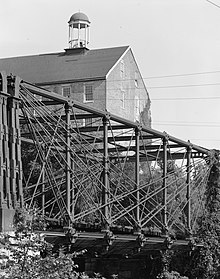Truss bridge
 Truss bridge for a single track railway, converted to pedestrian use and pipeline support | |
| Ancestor | beam bridge |
|---|---|
| Related | None |
| Descendant | Cantilever bridge, truss arch bridge, transporter bridge, lattice bridge |
| Carries | Pedestrians, pipelines, automobiles, trucks, light rail, heavy rail |
| Span range | Short to medium |
| Material | Timber, iron, steel, reinforced concrete, post-stressed concrete |
| Movable | May be movable - see movable bridge |
| Design effort | Medium |
| Falsework required | Depends upon length, materials, and degree of prefabrication |
A truss bridge is a bridge composed of connected elements (typically straight) which may be stressed from tension, compression, or sometimes both in response to dynamic loads. For purposes of analysis most truss bridges may be considered to be pin jointed where the straight components meet. A more complex analysis may be required where rigid joints impose significant bending loads upon the elements.

In the bridges illustrated above the vertical members are in tension, lower horizontal members in tension, shear, and bending, diagonal and top members are in compression. The central vertical member stabilizes the upper compression member, preventing it from buckling. If the top member is sufficiently stiff then this vertical element may be eliminated. If the lower chord (a horizontal member of a truss) is sufficiently resistant to bending and shear, the outer vertical elements may be eliminated.
The inclusion of the elements shown is largely an engineering decision based upon economics, being a balance between the costs of raw materials, off-site fabrication, component transportation, on-site erection, the availability of machinery and the cost of labor. In other cases the appearance of the structure may take on greater importance and so influence the design decisions beyond mere matters of economics. Modern materials such as prestressed concrete and fabrication methods, such as automated welding, have significantly influenced the design of modern bridges.
The truss may carry its roadbed on top, in the middle, or at the bottom of the truss. Bridges with the roadbed at the top or the bottom are the most common as this allows both the top and bottom to be stiffened, forming a box truss. When the roadbed is atop the truss it is called a deck truss, when at the bottom of a box truss a through truss, and where the sides extend above the roadbed but are not connected, a pony truss or half-through truss.
Sometimes both the upper and lower chords support roadbeds, forming a double-decked truss. This can be used to separate rail from road traffic or to separate the two directions of automobile traffic and so avoiding the likelihood of head-on collisions.

History in the United States

A few iron truss bridges were built in the United States before 1850. Bridges based on the Bollman truss (patented in 1852) were used successfully by the Baltimore and Ohio Railroad. Truss bridges became a common type of bridge to see built from the 1870s through the 1930s. Examples of these bridges still remain across the United States, but their numbers are dropping rapidly, as they are demolished and replaced with new structures. Wrought iron bridges in the U.S. started being built on a large scale in the 1870s. Bowstring truss bridges were a common truss design seen during this time, with their arched top chords. Companies like the Wrought Iron Bridge Company of Canton, Ohio and the King Bridge Company of Cleveland, Ohio became well-known companies, as they marketed their designs to different cities and townships. The bowstring truss design fell out of favor due to a lack of durability, and gave way to the Pratt truss design, which was stronger. Again, the bridge companies marketed their designs, with the Wrought Iron Bridge Company in the lead. As the 1880s and 1890s progressed, steel began to replace wrought iron as the preferred material. Other truss designs were used during this time, including the camel-back. By the 1910s, many states developed standard plan truss bridges, including steel Warren pony truss bridges. As the 1920s and 1930s progressed, some states, like Pennsylvania continued to build steel truss bridges, including massive steel through truss bridges for long spans. Other states, like Michigan, utilized standard plan concrete girder and beam bridges, and only a limited number of truss bridges were built.
External links

- Bridge Basics - A Spotter's Guide to Bridge Design - Illustrates many of the various types of truss arrangements used in bridges.
- Historic Bridges of Michigan and Elsewhere - Many photos of truss bridges are available on this informative and mainly truss-focused bridge website.
- Historic Bridges of the Midwest - An enormous database of historic bridges. Over 1000 truss bridges are listed here.
- Iron and Early Steel Bridges of Ohio - A comprehensive inventory of all remaining truss bridges in Ohio. Includes maps, photos, and invites visitor assistance in identifying extant or demolished bridges.
- Railroad Bridge Enthusiasts
- Matsuo Bridge Company: Bridge Types - Truss
